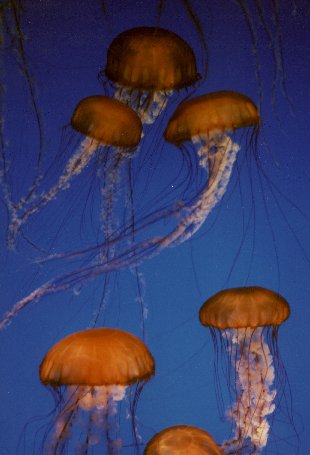by Larry
May, 2007Sea Life in Transition
Albeit at a first stage, we are now in the midst of only the sixth mass extinction in the ages of the sun's third planet. If the recent record of ocean life is indicative, this present time of extinction may disproportionately effect the more advanced types of beings. And in the wake of higher creatures' demise, scientists are noticing significant increases among the lesser or simpler kinds of life. The trend for ocean organisms is heading in the other direction from what we had come to expect, away from complexity and back in favor of greater simplicity. Over the span of life's existence on the planet, there may have been several ebbs and flows, a kind of yin and yang interaction or balance between the relatively simple vs. complex. But now it seems the latter life forms are once again on the wane. If so, four main factors are thought responsible for the shift: pollution; over fishing; wetland destruction; and global warming. Whatever the catalysts, as natural niches become vacant, nature tends to fill in the resulting voids. Those plants, animals, fungi, or other life examples that can adapt most quickly to the new conditions will, at least in the short-term, fare the best. Typically, it is the lower or simpler forms that dominate in such a competition. They have among the very oldest of DNA lines and so have within their chromosomes the greatest number of potential variations with which to adapt to new environmental circumstances. Also, they normally have much shorter life cycles than complex organisms and so in a very short time can satiate and accomodate still further a newly available environment, long before higher life forms have an opportunity to do so. Earlier, in healthy seas, a host of creatures would eat the simpler and often nuisance organisms, so that they would not become problematic. Now there may be little or nothing to limit their spread. What sea creatures are we likely to notice taking over in areas that previously had healthy coral reefs, marine mammals, kelp forests, sea turtles, millions upon millions of edible fish, shellfish, or the abundant krill that other animals have depended upon for food? In fact, the transformation has already begun, and the answers are not favorable to ocean life as our kind has known and loved it for hundreds of thousands of years. In "The Rise of Slime," Kenneth R. Weiss points out that the oceans are being radically altered and that much of the sea life we might consider "good," closer to us in nature's great family tree, is being replaced by "bad" forms of algae, bacteria, and jellyfish. Noxious examples abound:
What can be done to correct the situation and restore the natural network that has sustained higher sea life? As with the multiple changes that apparently are occurring under the overall label of "global warming," there is no quick fix. Degradations to oceanic environments went unrecognized for long enough that many of their effects are now irreversible. At best, the widespread adoption of much more environmentally favorable practices may forestall awhile the full extent of the transition. We are quickly returning to the type seas prevalent before the first creatures crawled out onto higher land, or before there were even vertebrates. Like the oil sector, the commercial ocean fishing industry may in the next few decades be on its last legs, unless before long we acquire a better taste than today for bacterial soups, algae noodles, or jellyfish sushi.
Source: The Rise of Slime. Kenneth R. Weiss in New Internationalist, Issue 397; January 2007. |